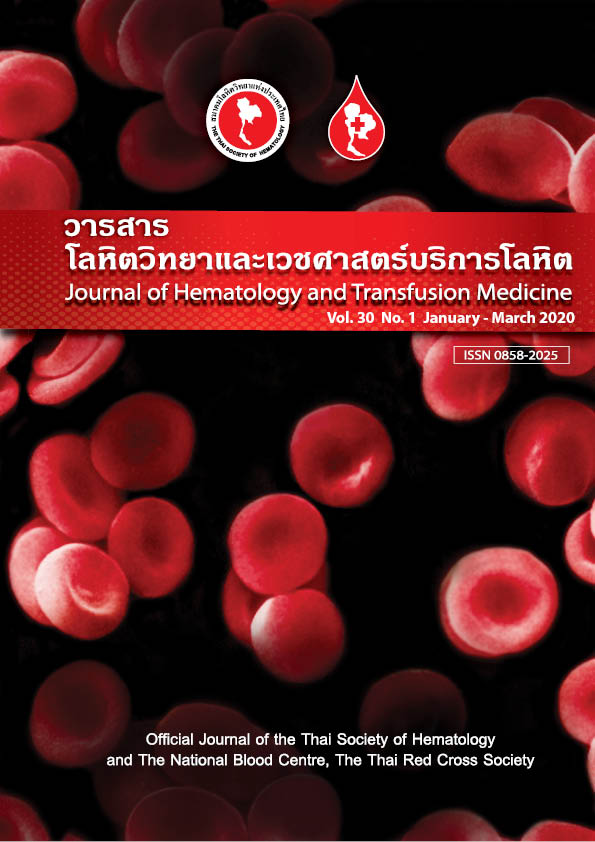Clinical manifestations and outcomes of systemic light chain amyloidosis: Chiang Mai University Hospital experience
Keywords:
AL amyloidosis, amyloidosis, immunoglobulin light chain, multiple myelomaAbstract
Objectives: The study’s primary objective aimed to investigate clinical manifestations including symptoms, signs and laboratory findings among patients with systemic light chain (AL) amyloidosis. The secondary objective was to study clinical outcomes among patients with AL amyloidosis.
Material and Methods: This study employed a retrospective design. We included all patients who had received a diagnosis of systemic AL amyloidosis and were treated in Chiang Mai University Hospital from January 2002 to October 2018. Data were obtained through the electronic database and clinical records including demographic data, clinical presentation, laboratory characteristics, treatment and outcomes.
Results: A total of 28 patients were identified. The median age at diagnosis was 63 years old (range 39 to 85 years old) and 71.4% were male. The most common initial clinical presentation was dyspnea on exertion (42.8%). The two most frequent organs involved among our patients were the heart (60.7%) and kidney (53.5%). Most patients underwent chemotherapy (85.7%), mainly a melphalan-based regimen (87.5%). Of the treated patients, 25% had a hematologic response (very good partial response 12.5% partial response 12.5%). The mortality rate was 82.1% with a median follow-up time of 11 months. Univariate and multivariable Cox regression analysis revealed that presence of Bence Jones protein in the urine was a poor prognostic factor for survival.
Conclusion: The most common organ involved in systemic AL amyloidosis was the heart. Overall survival of patients with AL amyloidosis was poor and most cases had a poor response to treatment.
Downloads
References
2. Gertz MA. Immunoglobulin light chain amyloidosis: 2018 Update on diagnosis, prognosis, and treatment. Am J Hematol. 2018;93:1169–80.
3. Wechalekar AD, Gillmore JD, Hawkins PN. Systemic amyloidosis. Lancet. 2016;387: 2641–54.
4. McKenna RW, Kyle RA, Kuehl WM, Harris NL, Coupland RW, Fend F. Plasma cell neoplasms. In: Swedlow SH, Campo E, Harris NL, Jaffe ES, Pileri SA, Stein H, et al, editors. WHO classification of tumors of haematopoietic and lymphoid tissues 2017 revised version. Lyon, France: IARC; 2017. p. 241-58.
5. Kyle RA, Larson DR, Kurtin PJ, Kumar S, Cerhan JR, Therneau TM, et al. Incidence of AL amyloidosis in Olmsted County, Minnesota, 1990 through 2015. Mayo Clin Proc. 2019;94:465-71.
6. Kyle RA, Gertz MA. Primary systemic amyloidosis: clinical and laboratory features in 474 cases. Semin Hematol. 1995;32:45-59.
7. Rajkumar SV, Dimopoulos MA, Palumbo A, Blade J, Merlini G, Mateos MV, et al. International Myeloma Working Group updated criteria for the diagnosis of multiple myeloma. Lancet Oncol. 2014;15:e538–48.
8. van Gameren II, Hazenberg BPC, Bijzet J, van Rijswijk MH. Diagnostic accuracy of subcutaneous abdominal fat tissue aspiration for detecting systemic amyloidosis and its utility in clinical practice. Arthritis Rheum. 2006;54:2015-21.
9. Gertz MA, Lacy MQ, Dispenzieri A, Hayman SR, Kumar SK, Leung N, et al. Effect of hematologic response on outcome of patients undergoing transplantation for primary amyloidosis: importance of achieving a complete response. Haematologica. 2007;92:1415-8.
10. Arnaud J, Philippe M, Veronique L, Leleu X, Benboubker L, Hermine O, et al. High-dose melphalan versus melphalan plus dexamethasone for AL amyloidosis. New Engl J Med. 2007;357:1083-93.
11. Dispenzieri A, Gertz MA, Kyle RA, Lacy MQ, Burritt MF, Therneau TM, et al. Serum cardiac troponins and N-terminal pro-brain natriuretic peptide: A staging system for primary systemic amyloidosis. J Clin Oncol. 2004;22:3751-7.
12. Muchtar E, Gertz MA, Kumar SK, Lacy MQ, Dingli D, Buadi FK, et al. Improved outcomes for newly diagnosed AL amyloidosis between 2000 and 2014: cracking the glass ceiling of early death. Blood. 2017;129:2111-9.
13. Yoobang N, Numbenjapon T. Diagnosis and management of systemic light chain amyloidosis. J Hematol Transfus Med. 2015;25:221-7.
14. Rittayamai N, Tscheikuna J. Amyloidosis and respiratory tract involvement: Report of two cases. J Med Assoc Thai. 2011;94:1150-3.
15. Gertz MA, Comenzo R, Falk RH, Fermand JP, Hazenberg BP, Hawkins PN, et al. Definition of organ involvement and treatment response in immunoglobulin light chain amyloidosis (AL). Am J Hematol. 2005;79:319-28.
16. Kumar S, Paiva B, Anderson KC, Durie B, Landgren O, Moreau P, et al. International Myeloma Working Group consensus criteria for response and minimal residual disease assessment in multiple myeloma. Lancet Oncol. 2016;17:e328–46.
17. Pinney JH, Smith CJ, Taube JB, Lachmann HJ, Venner CP, Gibbs SDJ, et al. Systemic amyloidosis in England: an epidemiology. Br J Hematol. 2013;161:525-32.
18. Quock TP, Yan T, Chang E, Guthrie S, Broder MS. Epidemiology of AL amyloidosis: a real-world study using US claims data. Blood Adv. 2018;2:1046-53.
19. Shimazaki C, Hata H, Iida S, Ueda M, Katoh N, Sekijima Y, et al. Nationwide survey of 741 patients with systemic amyloid light-chain amyloidosis in Japan. Intern Med. 2018;57:181-7.
20. Miyazaki K, Kawai S, Suzuki K. Abdominal subcutaneous fat pad aspiration and bone marrow examination for the diagnosis of AL amyloidosis: the reliability of immunohistochemistry. Int J Hematol. 2015;102:289–95.
21. Dispenzieri A, Kyle R, Merlini G, Miguel JS, Ludwig H, Hajek R, et al. International Myeloma Working Group guidelines for serum-free light chain analysis in multiple myeloma and related disorders. Leukemia. 2009;23:215-24.
22. Kyle RA, Linos A, Beard CM, Linke RP, Gertz MA, O’Fallon WM, et al. Incidence and natural history of primary systemic amyloidosis in Olmsted County, Minnesota, 1950 Through 1989. Blood. 1992;79:1817-22.
23. Sanchorawala V, Skinner M, Quillen K, Finn KT, Doros G, Seldin DC, et al. Long-term outcome of patients with AL amyloidosis treated with high-dose melphalan and stem-cell transplantation. Blood. 2007;110:3561-3.
24. Sanchorawala V, Sun F, Quillen K. Long-term outcome of patients with AL amyloidosis treated with high-dose melphalan and stem cell transplantation: 20-year experience. Blood. 2015;126:2345-6.
25. Gupta VK, Brauneis D, Shelton AC, Quillen K, Sarosiek S, Sloan JM, et al. Induction therapy with bortezomib and dexamethasone and conditioning with high-dose melphalan and bortezomib followed by autologous stem cell transplantation for immunoglobulin light chain amyloidosis: Long-term follow-up analysis. Biol Blood Marrow Transplant. 2019;25:e169-73.



